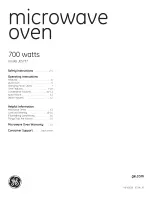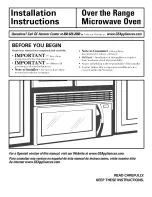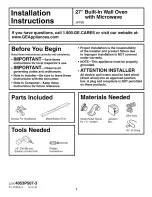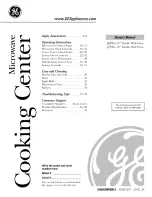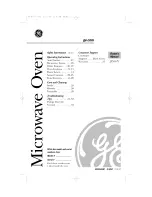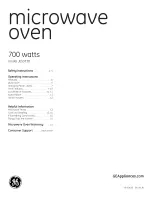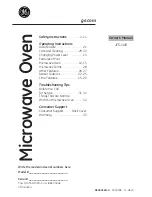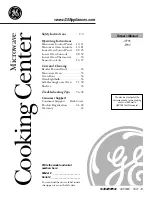
Drawer Microwave
(Models MWD24-2 / MWD30-2)
Component Removal
4-4
#813632 - Revision B - December, 2009
MICROWAVE MEASUREMENT PROCEDURE
1.
Requirements:
A.
Microwave leakage limit (Power density limit):
The power density of microwave radiation emitted by a
microwave oven should not exceed mW/cm2 at any point 5cm or more from the external surface of the oven,
measured prior to acquisition by a purchaser, and thereafter (through the useful life of the oven), 5 mW/cm2 at
any point 5cm or more from the external surface of the oven.
B.
Safety interlock switches:
Primary interlock relay switch shall prevent microwave radiation emission in excess
of the requirement as above mentioned. Secondary interlock relay and door sensing switch shall prevent
microwave radiation emission in excess of 5 mW/cm2 at any point 5cm or more from the external surface of
the oven.
2.
Preparation for testing:
Before beginning the actual measurement of leakage, proceed as follows:
A. Make sure that the actual instrument is operating normally as specified in its instruction booklet.
NOTES:
•
Survey instruments that comply with the requirement for instrumentation as prescribed by the perform-
ance standard for microwave ovens, 2 CFR 030.0(c)(3)(i), must be used for testing.
•
Survey instruments that comply with the requirement for instrumentation as prescribed by CSA and NHW
performance standard for microwave ovens must be used for testing recommended instruments are,
NARDA 800 and NARDA 8200.
B. Place the load of 275±5 ml (9.8 oz) of tap water initially at 20±5OC (68OF) in the center of the oven cavity.
The water container shall be a low form of 600 ml (20 oz) beaker with an inside diameter of approx. 8.5 cm (3-
/2 in.) and made of an electrically non conductive material such as glass or plastic. The placing of this stan-
dard load in the oven is important not only to protect the oven, but also to insure that any leakage is meas-
ured accurately.
C. Set the cooking control on Full Power Cooking Mode.
D. Close the drawer and select a cook cycle of several minutes. If the water begins to boil before the survey is
completed, replace it with 275 ml of cool water.
3.
Leakage test:
Closed-drawer leakage test (microwave measurement):
A. Grasp the probe of the survey instrument and hold it perpendicular to the gap between the drawer and the
body of the oven.
B. Move the probe slowly, not faster than in./sec. (2.5 cm/sec.) along the gap, watching for the maximum indica-
tion on the meter.
C. Check for leakage at the drawer screen, sheet metal seams and other accessible positions where the continu-
ity of the metal has been breached (eg., around the switches, indicator, and vents). While testing for leakage
around the drawer, pull the drawer away from the front of the oven as far as is permitted by the closed latch
assembly.
D. Measure carefully at the point of highest leakage and make sure that the highest leakage is no greater than
4mW/cm2, and that the primary interlock switch/secondary interlock relay does turn the oven OFF before any
door movement.
BEFORE OPERATING OVEN AFTER SERVICE
1.
Disconnect the power supply cord.
2.
Make sure that a definite” click” can be heard when the microwave oven drawer is unlatched. (Hold the drawer
in a closed position with one hand, then pull the drawer open, this causes the latch leads to rise, it is then possi-
ble to hear a “click’ as the drawer switches operate.)
3.
Visually check the drawer and cavity face plate for damage (dents, cracks, signs of arcing etc.).
Do not operate the oven if any of the following conditions exist:
•
Drawer does not close firmly.
•
Drawer latch hook is damaged.
•
The drawer gasket or seal is damaged.
•
The drawer is bent or warped.
•
There are defective parts in the drawer interlock system.
•
There are defective parts in the microwave generating and transmission assembly.
•
There is visible damage to the oven.
Do not operate the oven: Without the RF gasket (Magnetron); if the wave guide or oven cavity are not intact; if
the drawer is not closed.































